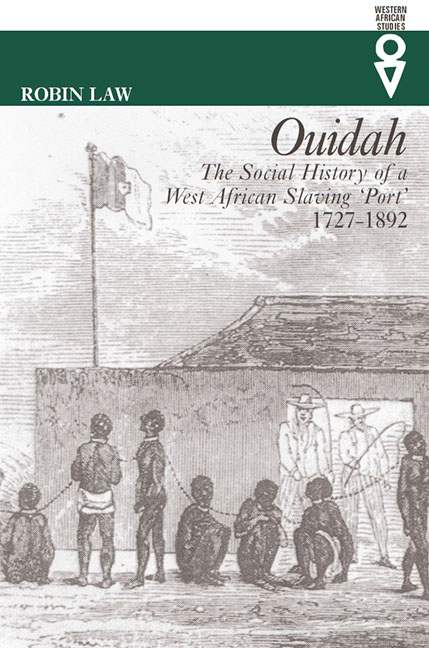Book contents
- Frontmatter
- Dedication
- Contents
- List of Maps & Tables
- Acknowledgements
- Abbreviations
- Map
- Introduction
- 1 Origins: Ouidah before the Dahomian conquest
- 2 The Dahomian Conquest of Ouidah
- 3 Dahomian Ouidah
- 4 The Operation of the Atlantic Slave Trade
- 5 De Souza's Ouidah The era of the illegal slave trade 1815 –39
- 6 The Era of Transition From slaves to palm oil 1840–57
- 7 Dissension & Decline Ouidah under King Glele 1858–77
- 8 From Dahomian to French Rule 1878-92
- Sources & Bibliography
- Index
7 - Dissension & Decline Ouidah under King Glele 1858–77
Published online by Cambridge University Press: 25 October 2017
- Frontmatter
- Dedication
- Contents
- List of Maps & Tables
- Acknowledgements
- Abbreviations
- Map
- Introduction
- 1 Origins: Ouidah before the Dahomian conquest
- 2 The Dahomian Conquest of Ouidah
- 3 Dahomian Ouidah
- 4 The Operation of the Atlantic Slave Trade
- 5 De Souza's Ouidah The era of the illegal slave trade 1815 –39
- 6 The Era of Transition From slaves to palm oil 1840–57
- 7 Dissension & Decline Ouidah under King Glele 1858–77
- 8 From Dahomian to French Rule 1878-92
- Sources & Bibliography
- Index
Summary
Although in the early 1850s Dahomey had appeared to be embracing the transition from the slave trade to that in palm oil with some success, later in the decade the oil trade began to run into difficulties. Most immediately, these were caused by a fall in the world price of palm oil. The price in the UK reached a peak of £48 per ton in 1854, but then declined, averaging only around £43 during the rest of the 1850s and falling below £40 in the 1860s. How far this was reflected in prices paid on the African coast is unclear. As was seen in the previous chapter, the expansion of oil exports at Ouidah had been stimulated by a rise in prices to $8 per measure ($142 per ton) by 1852, and Gezo then decreed a further rise to $12 per measure ($213 per ton). By 1857, however, the price is quoted as 3 gallons to the dollar, or $6 per measure ($107 per ton) (see Table 6.1). On the face of it, therefore, prices were substantially lower from the mid-1850s; and in apparent confirmation, Burton in 1863/4 reported local complaints of ‘commercial depression’. Interpretation of these prices, however, is complicated by the depreciation of the local cowry currency, due to the importation of large quantities of the cheaper Zanzibar cowries from the 1840s onwards. Already in 1850, Forbes noted that, although the ‘head’ of 2,000 cowries still had a ‘nominal’ value of one dollar, actual silver dollars passed at between 2,400 and 2,600 cowries and cowries fell further to 5 heads for $3 (3,333 cowries to the dollar) in 1851, 2 heads (4,000) to the dollar by the beginning of 1852 and 21⁄2 heads (5,000) by 1863/4. This devaluation of cowries was reflected in an inflation of local prices: Burton in 1863/4 reported that prices in the Ouidah market had doubled during the previous ten years.
- Type
- Chapter
- Information
- OuidahThe Social History of a West African Slaving Port 1727-1892, pp. 231 - 262Publisher: Boydell & BrewerPrint publication year: 2017

